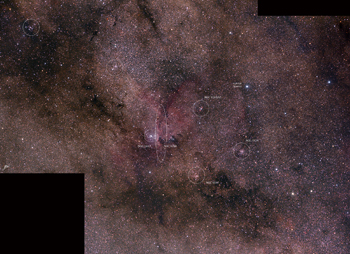 |
CHAMÄLEON + ONJALA OBSERVATORY DeepSky | SITEMAP HOME CHAMÄLEON |
|
 |
|||
| « back to overview widefield | Load higher resolution (2000 x 1500 Pixel 4000 x 2500 Pixel) | Object description |

The central region of NGC 6188 is a 20 by 12 arcmin emission and reflection nebula. The total area, also cataloged as RCW 108, covers an apparent size of up to 3.5 degrees in longitude. The "dramatic landscape" lies in the southern constellation Ara (the Altar) and contains a wealth of interesting galactic objects. The central region covers a real diameter of about 35 light-years (in full length over 300 light-years).
The entire region is crisscrossed by an abundance of smaller and larger, dark and relatively cool gas and dust clouds. The distance to the solar system is about 4500 light years. NGC 6188 was discovered by John Herschel on April 15, 1836.
NGC 6188 contains in its brightest regions the open star cluster NGC 6193, which forms the center of the ARA OB1 association. It is similar in age to NGC 6231 in the Scorpio star-forming region, being only about 5 million years old. In our mosaic it appears nearly point-like. It contains two extremely hot, blue stars of spectral types O5 and O7. These two stars provide the vast majority of the ionization energy that makes NGC 6188 glow.
The high-energy ultraviolet radiation and intense stellar winds from the stars of NGC 6193 have already triggered the next generation of star formation in the surrounding clouds of gas and dust. In the conspicuous, vertical boundary between dark clouds and reddish-luminous H-II regions (which is also known as the Rim or Reef Nebula), the new stars form as cloud parts collapse and heat up.
NGC 6193 is classified as a type II 3 p according to Trumpler. Its apparent diameter of just under 14 arcminutes correspond to a diameter of about 14 light-years at the distance of 4500 light-years. The star cluster was discovered by James Dunlop on May 14, 1826.
Another interesting object stands southwest of NGC 6193. It is an S-shaped reddish nebula with a bright blue star in the center. It is NGC 6164/6165, a bipolar planetary nebula with the Wolf Rayet star HD 148937 in its center. It also has the popular name "Propeller Nebula". Obviously the Wolf Rayet star not only created the small s-shaped nebula, but much longer time ago also created the surrounding round nebular structure, which is not visible here in the image. On narrow band images these structures become much more visible.
NGC 6164/65 was discovered by John Herschel on July 1, 1834. John Herschel was a son of Friedrich Wilhelm Herschel and observed a time of South Africa the southern starry sky.
 |
Furthermore, our mosaic shows a large number of open
galactic star clusters. The most conspicuous are (marked in the image)
NGC 6167, 6134, 6200, 6204 and 6250. Except for
NGC 6200 the clusters are in about the same distance as NGC 6193 and are
probably part of the ARA OB1 association. NGC 6200 stands much farther away from the solar system with a distance of 6700 light-years. It is classified as type III 2 m according to Trumpler and discovered by John Herschel on July 1, 1834. A detailed view of NGC 6188/6193, taken with long focal length, we show here. A detailed view of NGC 6164/6165, taken with long focal length, we show here. This image shows very impressively the outer nebular structure around NGC 6164/6165. « Click here or the thumbnail to load a large annoted image. |
 |
 |
 |
 |
 |
 |
 |
| Sun | Moon | Solar System | DeepSky | Widefield | Miscellaneous | Spec. Projects |